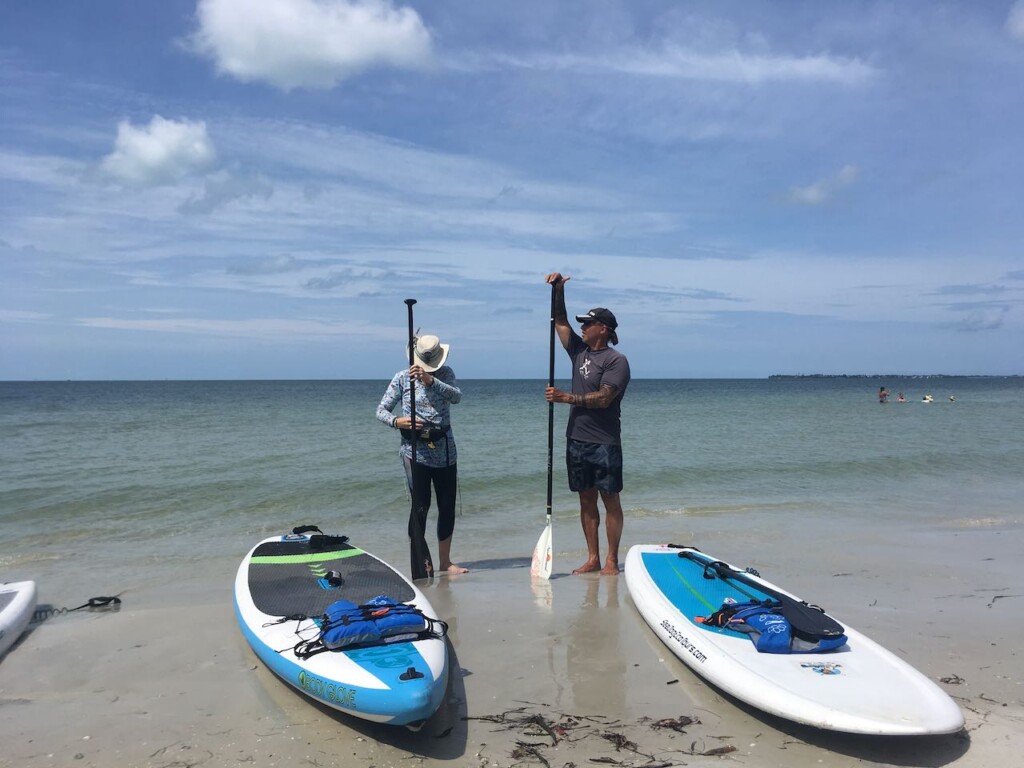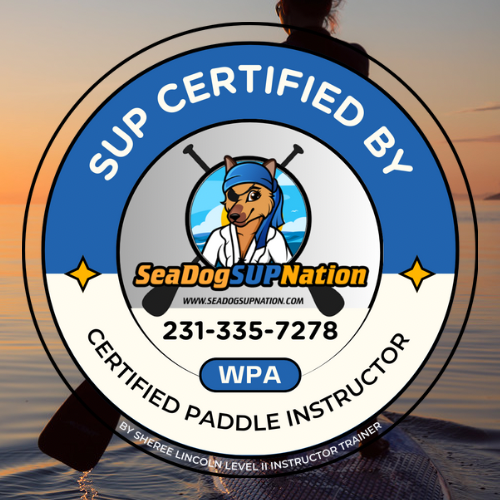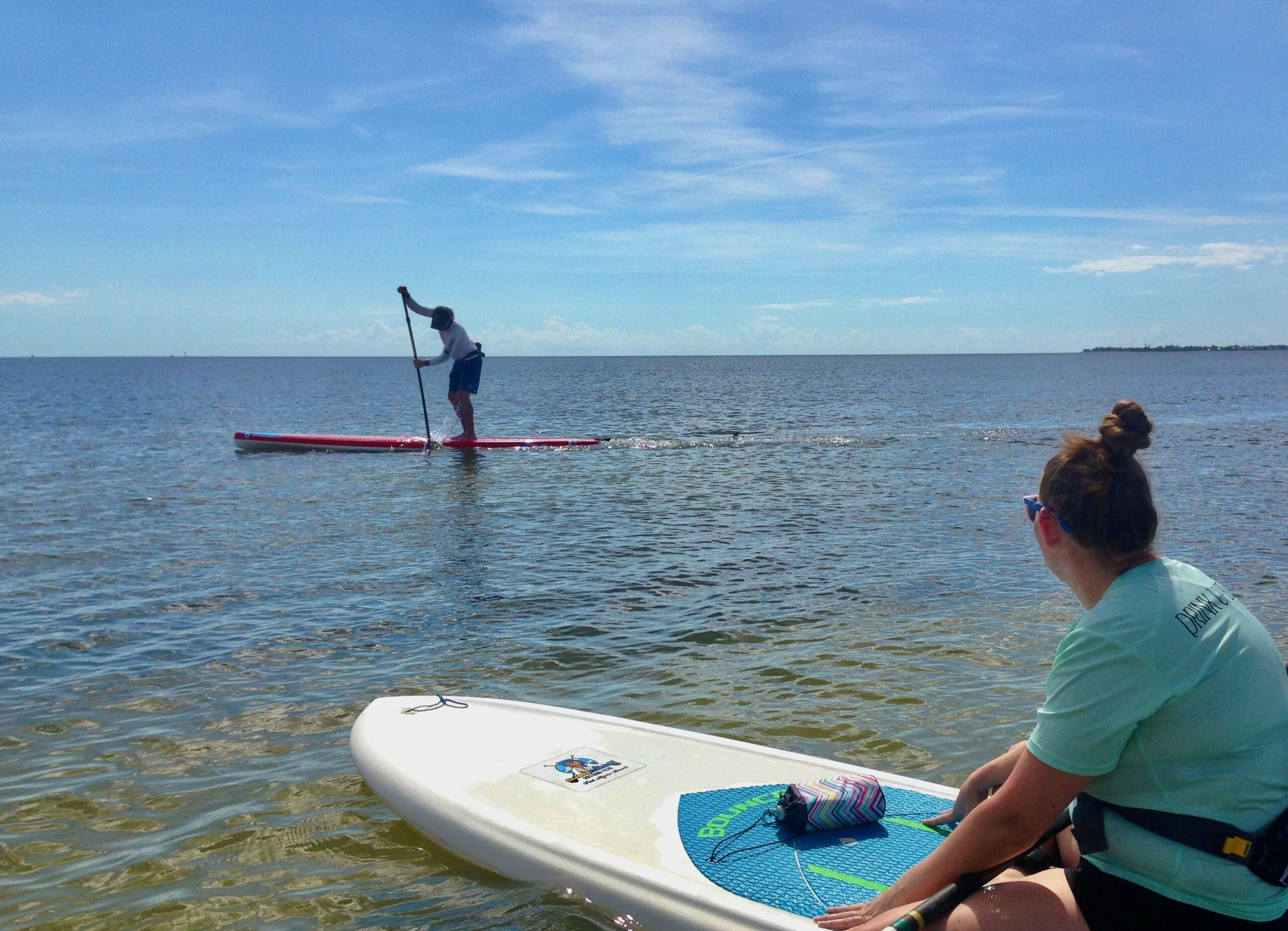The Power of the Paddle
Getting in the Flow Paddle Boarding
Paddle Boarding helps us get in the flow and enjoy being in the moment. Using proper paddling technique can make our experience on the water even better. Setting your paddle to the proper height can save your shoulders, increase your confidence as a paddler and allow you to paddle for longer intervals. It can also help you learn to paddle straighter and faster. It may even save your life in if you get caught out on the water in bad conditions when the wind and waves come up. If you are an instructor, creating a way to share the basic tenants of proper paddling technique will make your tours and lesson better for your students allowing them to go home with a skill they can take on their next paddle adventure. These are the techniques I share with my clients when teaching at Sea Dog SUP Nation and Sea Dog Eco Tours.
How you use your paddle boarding paddle is an important component of any successful paddling boarding session. Often, when people first learn to paddle board, they are self taught. Some people end up using efficient paddling technique and other ends up developing bad habits. I have been teaching paddling boarding and guiding paddle board tours for over 12 years. During that time I have taken lessons, workshops and received certifications from some of the best paddle boarder instructors in the business. People like Adam Pollack from OSUP, Dan Gavere a white water instructor, Zack Kekoa Schweitzer an athlete and ocean enthusiast, Seychelle a very successful racer and coach, Tara McCabe, Yoga Teacher and Instructor at Lazy Dog Paddle in Key West, Brody Welte founder of PaddleFit where I am a PaddleFit Pro Coach and the World Paddle Association where I am a Level II Instructor Trainer. Today I would like to share how I teach people to use the paddle board paddle with good technique. When I work with my customers, students and guests I take the basics from this article and choose descriptions and words that help me meet them at their level of paddling and understanding. This is a guideline that any paddle board instructor could use to create their own outline and verbiage to teach how to use the paddle with proper technique and efficiency.

The first thing to do is set your paddle to the appropriate length for you. A good place to start with is by resting your hand on top of the paddle by bending at the wrist, wresting you wrist against the egg shaped curve of the paddle handle. Next slide your hand back toward you until your hand is resting comfortably on the paddle grip with your fingers grasping the egg shaped handle and your knuckles parallel to the sky. If your hand is wrapped too far forward on the handle or too far down the shaft, you will get a weird bend in your wrist and it will feel uncomfortable. With the segment of your hand, between both sets of knuckles resting on the top of the paddle, you will have great range of motion.
There are alternative ways to establish paddle height. A second method is to stand with the paddle blade alongside your right foot. Stretch your arm straight up to the sky, with your palm facing forward toward the paddle handle. Your paddle height should be set so that the top of the paddle handle reaches about 1 1/2 to 2 inches below where the palm of you hand meets your wrist. Generally you paddle will bet set to a height about 6’ to 8’ taller than you are.
Next, it is important to be familiar with the optimal location to place your lower hand on the paddle shaft so that when you are paddling. Your hand will be acting as a fulcrum. Your lower handle will be cradling the paddle shaft and should not have a tight grip on it. In this A really good way to do this is to raise your hands above your head, resting the paddle shaft on the crown on your head with your arms bent from the wrist at right angles to your upper arm similar to a goal post position (or a giant U shape).
It is also good to make sure the paddle blade is facing the right direction. You can lose a lot of power, with your stroke, if the power face is not facing you. This can cause the blade to wobble, also called feathering, as it goes through the water. This causes additional turbulence in the water and makes it difficult for the blade to flow nicely through the water. Often you can establish which way the log on the blade should be facing, toward you or away from you. A sticker can be placed on top of your blade so to give you a visible guide, when looking down on the paddle, as it enters the water. As a guide it is helpful to have stickers on the top side of all of your paddle shafts, including your own, since your guests will be looking to you for guidance and copy the way you are using your paddle.
Using proper technique, when paddling will help you avoid injury. Incorrect paddling, by pulling the paddle toward you can easily cause tennis elbow because you are using small muscles, especially the ones around your elbow. Instead we stack our hands on the paddle shaft. One hand on the handle and the other about 21” to 2’ down the shaft. This distance between your hands was established when we we found the appropriate place for your lower hand, earlier in the lesson.
Standing on the board you should be in an athletic stance with your legs shoulder width apart similar to how you would standing preparing to do a squat, the position you would be in when placing tennis or pickle ball, even the way you would be sitting on a horse. Your knees should be soft and flexible so that you flex to balance on the board as it moves through the water and is effected by the wind and water in order to more easily adjust and balance on the board. This uses big shoulder and arm muscles and will allow you to paddle longer without tiring.
As you start to paddle on one side of the board you will be reaching forward with the blade, your hands will be stacked as described earlier, and you will reach forward and place the blade in the water, entering the water at an angle, as if we were stabbing a fish. This is called the reach. This method uses bigger muscles of your entire arm, supported by your shoulder muscles as you punish forward and down. On the return your lower arm will naturally return toward the trunk of y our body. Some people let their arm naturally bend and it will reach your waist and then you will start a new stroke. Other people, especially if they are racing or on a downwind paddle, or want to get more power front the stroke, will keep the lower arm extended as it returns and utilize your core muscles as part of the return from a forward hip thrust (more about this in another lesson). As you push the paddle shaft forward with your top hand, you will also be pushing down on the paddle shaft, driving the blade lower into the water as the board starts to glide by the paddle. You are not pulling the paddle toward you, the board is actually moving past the paddle shaft, partly from the momentum that will build up as you continue to paddle and partly by the use of the hip thrust (which is part of another lesson).
If you paddle too long on one side your board will start turning. When switching sides it’s important to keep both hands on the paddle shaft and not let go of the shaft to toss the paddle from side to side. If you do you could lose your paddle and as the old saying goes, “be up a creek without a paddle”. Instead the optimal method to use when you switch sides is to take your top hand off the paddle handle and place it below your bottom hand just as you are lifting the blade of the paddle toward the front of the board. Your top hand should be placed directly below where your lower hand is still holding the paddle. This will help you lift the paddle blade up and across the front of the board (the bow) to the other side while at the same time a you will slide the hand that is now above your other hand, up toward the top up the shaft until your palm and then grip the paddle handle once again in the manner we described earlier. By this time you should have guided the blade across to the other side of the board, in the reach position we discussed earlier, and you will be ready for your next stroke. For more casual paddling, some people do not position themselves quite as well for the next stroke especially for new paddlers as they may be focused more on starting over. Eventually your paddling technique will become muscle memory and extending your reach, as you lift the shaft and cross over the board, is more efficient.
Paddle boarding is a sport that helps you get in the flow. It can help you find balance both on the board and in life as well as maintain or develop a solid core. I am happy to have shared these techniques on how to use your paddle with good technique. Take these ideas with your and go paddle!

